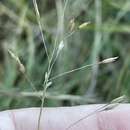Comprehensive Description
provided by North American Flora
Sporobolus teretifolius Harper, Bull. Torrey Club 33: 229
1906.
Perennial; culms cespitose, erect, wiry, glabrous, without nodes above the base, 60-80 cm. tall; sheaths pilose at the throat, the lower shining and becoming somewhat flattened, the uppermost very long; ligule erose, about 0.5 mm. long; blades elongate, slender, terete or tightly folded above the channeled base, wiry, flexuous, glabrous, pilose on the upper surface at base, mostly less than 1 mm. thick; panicle pyramidal, open, narrow, 15-20 cm. long, the axis angled, scaberulous, the capillary branches, branchlets, and pedicels ascending or somewhat spreading, scabrous, the pedicels, if branches of the third order, often shorter than the spikelets, if of the second order, longer; spikelets purplish-brown, 4—4.5 mm. long, glabrous; first glume half as long as the spikelet or a little longer, the second equaling the lemma and palea.
Type locality: Near Moultrie, Georgia {Harper 1642).
Distribution: Moist pine barrens, Georgia (Moultrie, the type, and Irby, Tracy 1483) and North Carolina (Southport, Fults 1816).
- bibliographic citation
- Albert Spear Hitchcock. 1937. (POALES); POACEAE (pars). North American flora. vol 17(7). New York Botanical Garden, New York, NY
Physical Description
provided by USDA PLANTS text
Perennials, Terrestrial, not aquatic, Stems nodes swollen or brittle, Stems erect or ascending, Stems caespitose, tufted, or clustered, Stems terete, round in cross section, or pol ygonal, Stem internodes hollow, Stems with inflorescence less than 1 m tall, Stems, culms, or scapes exceeding basal leaves, Leaves mostly cauline, Leaves conspicuously 2-ranked, distichous, Leaves sheathing at base, Leaf sheath mostly open, or loose, Leaf sheath smooth, glabrous, Leaf sheath hairy at summit, throat, or collar, Leaf sheath and blade differentiated, Leaf blades linear, Leaf blades very narrow or filiform, less than 2 mm wide, Leaf blades 2-10 mm wide, Leaf blade margins folded, involute, or conduplicate, Leaf blades mostly glabrous, Ligule present, Ligule a fringe of hairs, Inflorescence terminal, Inflorescence an open panicle, openly paniculate, branches spreading, Inflorescence solitary, with 1 spike, fascicle, glomerule, head, or cluster per stem or culm, Inflorescence branches more than 10 to numerous, Flowers bisexual, Spikelets pedicellate, Spikelets laterally compressed, Spikelet less than 3 mm wide, Spikelets with 1 fertile floret, Spikelets solitary at rachis nodes, Spikelets all alike and fertille, Spikelets bisexual, Spikelets disarticulating above the glumes, glumes persistent, Rachilla or pedicel glabrous, Glumes present, empty bracts, Glumes 2 clearly present, Glumes distinctly unequal, Glumes shorter than adjacent lemma, Glumes 1 nerved, Lemmas thin, chartaceous, hyaline, cartilaginous, or membranous, Lemma similar in texture to glumes, Lemma 1 nerved, Lemma glabrous, Lemma apex acute or acuminate, Lemma awnless, Lemma straight, Palea present, well developed, Palea membranous, hyaline, Palea about equal to lemma, Palea 2 nerved or 2 keeled, Stamens 3, Styles 2-fid, deeply 2-branched, Stigmas 2, Fruit - caryopsis, Caryopsis ellipsoid, longitudinally grooved, hilum long-linear.

